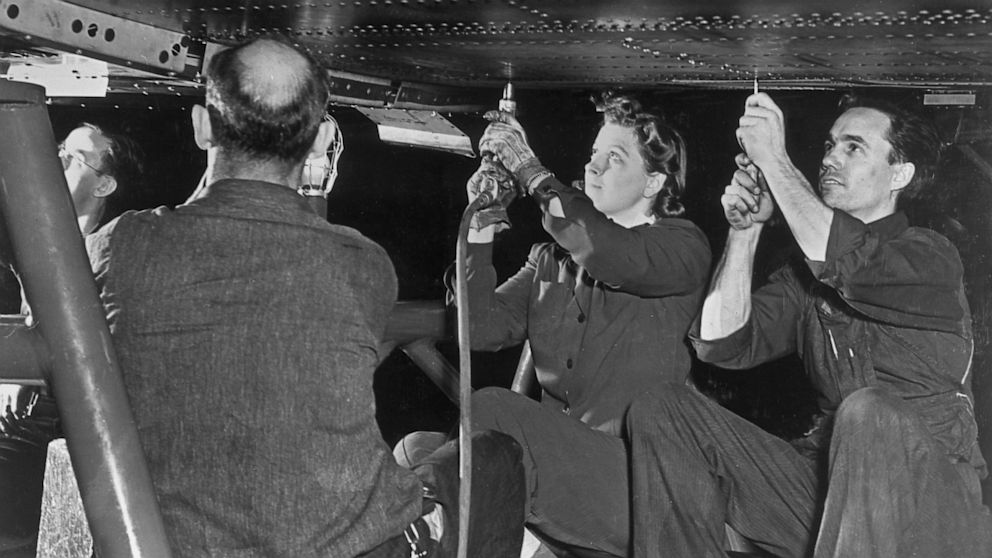Rosie the Riveter Museum: Fundraisers Try to Preserve WWII's 'Arsenal of Democracy'
Rosie the Riveter and other WWII heroes likely will get a new museum.

Aug. 1, 2013 — -- Rosie the Riveter may soon be getting a new home.
If backers can raise $8 million by Oct. 1, part of Ford's former Willow Run factory in Ypsilanti, Mich., will be turned into an extension of a neighboring museum that would honor the accomplishments of Rosie and some 40,000 workers like her who helped win World War II by building so many bombers so fast that Germany and Japan could not compete.
Retired GM executive Bob Lutz, co-chairman of the museum's fundraising campaign, calls Willow Run significant to American history in two ways.
The first way is industrial: At 5 million square feet and covering 332 acres, Willow Run, when built in just five months in 1941, was the largest factory of any kind in the world. It was here, says Lutz, that auto industry production methods were first applied to the building of aircraft on a mass scale. At its height, Willow Run produced one four-engine B-24 Liberator heavy bomber every 55 minutes -- 9,000 planes by war's end. It built more bombers in a month than Japan built in a year.
The second way is social. It was here, says Lutz, that women entered the war effort in a big way, doing jobs like riveting, which previously had been done only by men. One female riveter in particular -- Rose Will Monroe -- caught the attention of Hollywood producers who were touring Willow Run, looking to cast a government film. "Rosie" Monroe played herself in the movie, and went on to become a symbol of women's contribution to the war effort.
Monroe and workers like her, says Lutz, were the civilian side of "the greatest generation." It was through their efforts that Willow Run got the nickname "arsenal of democracy." A recent book, "Freedom's Forge," tells that story.
"The whole symbol of Rosie the Riveter," says Lutz, "stemmed from that plant. It became a significant thing in the history of the empowerment and emancipation of women."
Ray Hunter, chairman of the Yankee Air Museum, located next to Willow Run, says the factory was among the first workplaces to offer equal pay for equal work. It was integrated racially. And it was a union shop.
The Yankee Air Museum celebrates both aspects of the factory's historical significance. Its collection includes a B-52 bomber, a B-17G bomber, a B25 and assorted postwar fighters, says Lutz. He and Hunter hope to acquire one of the country's few surviving B-24s.
Hunter, Lutz and other supporters of the Yankee Air Museum want to expand it into 175,000 square feet of the Willow Run factory, which has sat idle since 2010, when GM, which had taken over the property from Ford and other successors, stopped making transmissions there.
Following GM's bankruptcy, the property became the responsibility of the RACER Trust, which has tried without success to find a buyer. As a RACER press release puts it diplomatically, "market demand has been unsatisfactory."
RACER's announced plan is eventually to dismantle and remove the 5-million-square-foot building except for the 175,000 feet that would be left for use by the new, expanded Yankee Air Museum. The museum, says RACER in a statement, "has presented a compelling vision."
RACER's original deadline for the museum's raising the necessary $8 million had been Aug. 1. It since has extended the deadline to Oct. 1.
Rosie the Riveter's Factory Gets 2-Month Reprieve
What happens if the museum's fundraising efforts fail?
"Our piece of the building will share the same fate as the rest: demolition," says Hunter.
Lutz expects the campaign to succeed. $4.5 million has been raised already, he says, including $2 million he says he persuaded GM to donate.
Hunter hopes the rest can be raised through contributions to the campaign's website, savethebomberplant.org, by contacting individuals able to make large gifts, and by tapping the surviving companies that once were part of the "arsenal of democracy."




